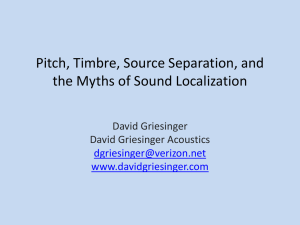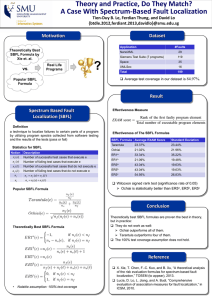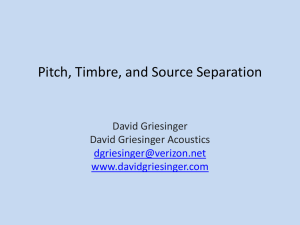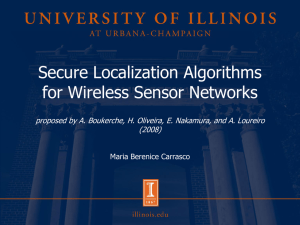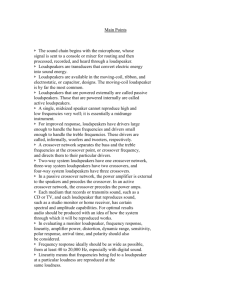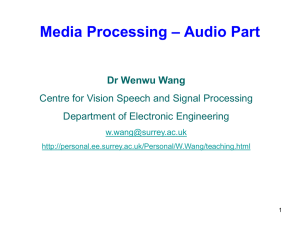Pitch, Timbre, Source Separation, and the Myths
advertisement
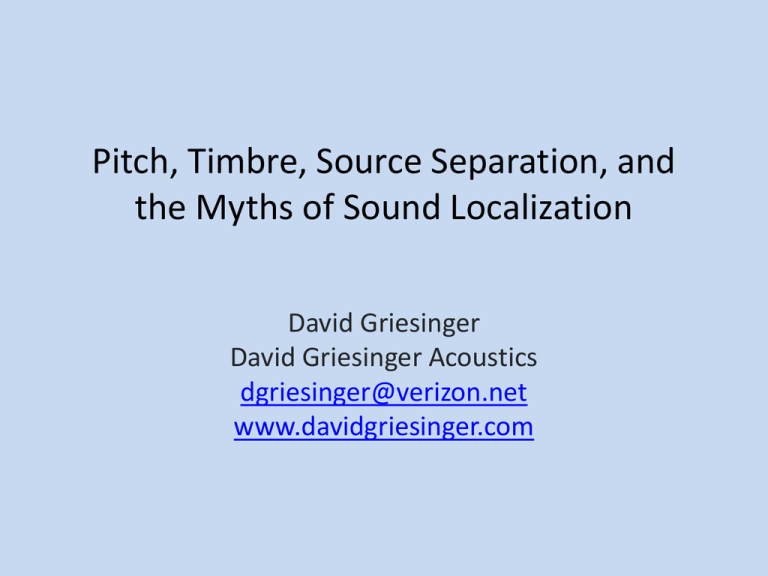
Pitch, Timbre, Source Separation, and the Myths of Sound Localization David Griesinger David Griesinger Acoustics dgriesinger@verizon.net www.davidgriesinger.com Sound Localization in Natural Hearing • The sensitivity of human hearing is weighted to the frequencies of vocal formants. – These frequencies carry most of the information in speech – And they also carry most of our ability to localize sounds • Vertical localization is almost entirely above 1000Hz • So elevated speakers for “3d” audio need not be large and heavy! Transfer function from sound outside the head through the outer and middle ear. Notice that the pesky low frequencies are largely filtered away, and there is almost 8dB of boost at 3kHz. Separation of simultaneous sounds • The author’s current work concentrates on the brain processes that enable our ears to separate simultaneous sounds into independent neural streams. – At formant frequencies separation requires that sounds have a definite pitch, and multiple harmonics above 1000Hz. – The phases of the harmonics must not be altered by acoustics in the first 100ms. • If sounds can be separated by pitch they can be individually localized even in the presence of noise or other pitched sounds. • But if the signal is speech or music with definite pitches we can easily localize and understand two simultaneous speakers or musicians. • Houtsma found that two simultaneous monotone speech signals in the same location can be separately understood if the pitch difference is only half a semitone, or 3%. – The author has examples of pitch separation of one semitone on his web-site • Source separation, perceived distance, clarity of localization, and clarity of sound are ALL related to the same physics of information Clarity, Distance, and Audience Attention • We detect “near” versus “far” instantly on perceiving a sound – “Near” sounds demand attention and sometimes immediate attention. • “Far” sounds can usually be ignored • Cinema and Drama directors demand that dialog be perceived as “Near” – Drama theaters are small and acoustically dry • Movie theaters are dry and use highly directional loudspeakers with linear phase response at vocal formant frequencies. • High sonic clarity and low sonic distance requires that harmonics in the vocal formant range are reproduced with their original phase relationships – Unmodified by loudspeaker characteristics or reflections. • This aspect of sound reproduction is not commonly recognised, either in live performance or in sound playback. – Tests of microphone techniques where the microphones are beyond the room critical distance are of limited value! Example of Clarity for Speech • This impulse response has a C50 of infinity – STI is 0.96, RASTI is 0.93, and it is flat in frequency. In spite of high C50 and excellent STI, when this impulse is convolved with speech there is a severe loss in clarity. The sound is muddy and distant. The sound is unclear because this IR randomizes the phase of harmonics above 1000Hz!!! Demonstration • The information carried in the phases of upper harmonics can be easily demonstrated: Dry monotone Speech with pitch C Speech after removing frequencies below 1000Hz, and compression for constant level. C and C# together Spectrum of the compressed speech It is not difficult to separate the two voices – but it may take a bit of practice! What happens in a room? Measured binaural impulse response of a small concert hall, measured in row 5 with an omnidirectional source on stage. The direct level has been boosted 6dB to emulate the directivity of a human speaker. RT ~ 1s Looks pretty good, doesn’t it, with plenty of direct sound. But the value of LOC is -1dB, which foretells problems… Sound in the hall is difficult to understand and remember when there is just one speaker. Impossible to understand when two speakers talk at the same time. C in the room C# in the room C and C# in the room together • All these effects depend on the coherence of upper harmonics. When sound is reproduced over multiple loudspeakers this quality usually suffers. This difficulty applies both to Ambisonics and WFS, especially because spatial aliasing is significant at formant frequencies Sound separation: Localizing a String Quartet From the author’s seat in row F behind the lady in red the string quartet was +-10 degrees in width. But in the presence of substantial reverberation it was possible to distinctly localize all four players with eyes closed, even when they played together. This implies a localization acuity of better than three degrees. With just slightly more reverberation it was not possible to localize the musicians at all. Perception of reverberation and envelopment • The goal of the ear/brain is to extract meaningful sound objects from a confusing acoustic field. – To the brain reverberation is a from of noise. – Where possible the brain stem separates direct sound from reverberation, forming two distinct sound streams: foreground and background. • Perceiving reverberation and envelopment is only possible when the direct sound can be separately perceived!!! – Clarity of the front image is a vital part of this process. – When the front image is muddy reverberation becomes a part of the front image and cannot be localized. • These facts are unappreciated in current concert hall design. – Almost invariably a recording has a clearer front image than a typical concert seat, where “well blended” sound is all you can hear. – It need not be so. With good acoustic design a concert seat can have better clarity and envelopment than any recording reproduced over loudspeakers. Localizing separated sounds in natural hearing • It is well known that we localize sounds through: – the Interaural Level Difference (ILD) – and the Interaural Time Difference (ITD) – Experiments with sine tones show that ITD is not useful above 2kHz due to frequency limits on nerve firings. – And that ILD loses accuracy below 1kHz as head shadowing decreases. • But high harmonics in the 1kHz to 4kHz range of low frequency fundamentals contain nearly all the information of speech – And also provide timbre cues that identify musical instruments. – When these harmonics are present we find that we can localize tones accurately with ILD • To understand our ability to localize speech and music we need to use signals that include harmonics – When harmonics are present our ability to localize can be extremely acute, +2 degrees or better ILD differences in human hearing Note that the 2 to 3dB of level difference between the two ears is nearly constant in the vocal formant range MIT Kemar HRTF for 0 degrees elevation and 5 degrees azimuth. Head shadowing is >2dB above 800Hz. If we assume a 1dB threshold for level differences we should be able to localize a frontal source with an uncertainty of only 2 degrees. And we can… Individual Instruments vs Sections • Ability to localize individual instruments with an uncertainty of 3 degrees or better is possible in good acoustics. – The ability disappears abruptly when there are too many early reflections, and multiple instruments fall together in a fuzzy ball. – With eyes open the visual localization dominates, and we are typically not aware that auditory localization is lost. • When multiple instruments are playing the same notes (a section) the uncertainty increases dramatically. – The section tends to be both visually and sonically wide. • But in a performance of a Haydn Symphony by the Boston Symphony Orchestra under Ton Koopman, the string sections played without vibrato. – The visual image was wide – but the auditory image was of a single instrument, and was sharply localized at the center of the section. Summary of Natural Hearing • When early reflections are not too strong we are able to localize multiple sound sources with high precision – approximately two degrees. – If multiple people are talking simultaneously we are able to choose to listen to any of them. – If multiple instruments are playing we are able to follow the lines of several at the same time. • These abilities disappear abruptly when the early reflections exceed a certain level with respect to the direct sound. • The information responsible for these abilities lies primarily in harmonics above 1000Hz from lower frequency tones. • Localization for natural hearing is independent of frequency!!! – Acuity, the sharpness of localization, can vary, but the perceived position does not vary. • In the author’s experience a binaural recording from a great concert seat can have sharper localization over the entire width of the orchestra than the best recording reproduced over stereo loudspeakers. – But in a poor seat localization is considerably worse. Stereo Reproduction • Stereo recordings manipulate the position of image sources between two loudspeakers by varying time or level. With the common sine/cosine pan law a level difference of 7.7dB to the left should produce a source image half-way between the center and the left loudspeaker, or 15 degrees to the left. If we listen with headphones, the image is at least 30 degrees to the left. And the position is independent of frequency. With broadband signals the perceived position is closer to the left loudspeaker Sound diffracts around the head and interferes with sound from the opposite speaker Sound from the left speaker diffracts around the head and appears at the right ear. The diffracted signal interferes with the signal from the right loudspeaker – and at s~1600Hz the sound pressure at the right ear can be nearly zero. Sound panned to the middle between left and center is perceived beyond the loudspeaker axis at high frequencies. Note that frequencies we principally use for sound localization in a complex field the perceived position of the source is very different from the sine/cosine pan-law. The diagram shows the perceived position of a sound source panned half-way between center and left with the speakers at +-45 degrees. Delay Panning • Techniques such as ORTF combine amplitude and delay panning – But delay panning is even more frequency dependent. – And if a listener is not in the sweet spot Delay panning does not work. This graph shows the approximate position of third octave noise bands from 250Hz to 2000Hz, given a 200 microsecond delay. This delay corresponds to a 15 degree source angle to two microphones separated by 25cm. The panning angle is about 15 degrees at 250Hz – but it is nearly 90 degrees at 2000Hz. Stereo localization is an illusion based on fuzzy data • The only stable locations are left, center, and right – And center is stable only in the sweet spot. • Confronted with an image between center and left, or center and right, the brain must guess the location based on an average of conflicting cues. – The result can be beyond the speaker axis. • Our perception of sharp images between center and left or right is an illusion generated by our brain’s desire for certainty, and it’s willingness to guess. Headphone reproduction of panned images • Headphones reliably spread a panned image +-90 degrees – The frontal accuracy is about +-2.5 degrees – And the perceived position is independent of frequency – if the headphones perfectly match the listener’s ears • It is useful to adjust a 1/3rd octave equalizer with 1/3rd octave noise bands to obtain a stable central image. • Thus it is possible to hear precisely localized images from panpots when listening through headphones – But not with speakers. • I must emphasize that headphone reproduction requires accurate equalization of the headphones – ideally individually different for the left and right ear! Coincident Microphones • Coincident microphones produce a signal similar to a pan-pot. – But the range of the pan is limited. • The most selective pattern is figure of eights at 90 degrees (Blumlein) – A source 45 degrees to the left will be reproduced only from the left loudspeaker. – A 3.3 degree angle from the front produces a 1dB level difference in the outputs. • Not as good as natural hearing, but not too bad when listening through headphones. • To produce a “full left” or “full right” signal the peak sensitivity of one microphone must lie on the null of the other microphone. – Cardioid microphones can only do this if they are back-to-back (180 degrees apart) – To pick up a decorrelated reverberant field the microphones must be at least supercardioid. Cardioid microphones pick up a largely monaural reverberant field at low frequencies in the standard ORTF configuration. • If properly equalized hypercardioid or supercardioid microphones sound much better. Compare Soundfield and Binaural • When you use headphones to compare a binaural recording to a Soundfield recording with any pattern: – The soundfield has a narrower front image – (it is not as sharp) – more reflected energy – (there is no head shadowing) – And less envelopment – (the direct sound is less distinct) • Comparing a binaural recording on headphones to a Soundfield recording on speakers is not a reasonable thing to do! Ambisonics and WFS • Ambisonics has a problem with head shadowing. – The lateral velocity vector is created by subtracting the left loudspeaker sound from the right loudspeaker sound. – But if the head is in the way the signals do not subtract – and the lateral sound is perceived stronger than it should be – and often as excess pressure. – Even in high order Ambisonics the frequency dependent panning problems still exist between loudspeakers. • This results in a lower Direct to Reverberant ratio at frequencies above ~500Hz. – Gerzon knew all about the problem, switching to crossed hypercardioid patterns above 500Hz. – The resulting directional beams are about 100 degrees wide! And the front image has all the problems of stereo. • If more speakers are used accuracy of localization is not increased, as the first order patterns are not selective enough to limit reproduction to only two speakers at the same time 5.1 Front • A precise center location is perceived anywhere in the listening space, and not just at the sweet spot (sweet line). • Accuracy of localization in the front is greatly improved – As long as only two speakers are active a time. – This requires panning from center to left or center to right, and not simultaneously producing a phantom image from the left or right speakers. – An image panned to the middle from center to left is perceived at 30 degrees at 3kHz. – This is a factor of two improvement over two channel stereo. • But the localization accuracy of three front speakers is still far inferior to natural hearing. – A five channel, five speaker front array is considerably better – again as long as only two channels are active for a given sound source. 5.1 side and rear • Perceiving a discrete image at the side between the front and rear speaker is difficult or impossible. – Sharp localization is only possible if a single speaker is activated, either a front or a rear. • Amplitude panning between the two rear speakers is possible, with all the disadvantages of two-channel stereo. Vertical Localization • Vertical localization is achieved entirely through timbre cues above 1000Hz. • Sounds in the horizontal plane lack frequencies in the range of 6000-10000Hz. • Augmenting these frequencies with loudspeakers above and forward of the listener leads to a pleasing sense of natural reverberation. – Two loudspeakers above the listener reproducing decorrelated reverberation sound much better than one. – The best location is to the left and right 60 to 80 degrees above the listener. – The signals reproduced can be derived from the reverberant component of a stereo or 5.1 recording. Conclusions • Localization in natural hearing takes place mostly at frequencies above 1000Hz, and has a precision of ~ 2 degrees in the horizontal plane. – With care this precision can be reproduced over headphones from a binaural or amplitude panned recording. • Commonly used pressure-gradient microphone techniques are not capable of capturing sound direction with this precision. – The vey best they an do is about four degrees, and techniques that use cardioid microphones give at best about 8 degrees. • Two channel loudspeaker reproduction suffers from frequency dependence for frequencies above 1000Hz, spreading apparent localization of a panned image over ~30 degrees. – The brain must make a best guess for the perceived position of a source – and the frequency spread is sometimes audible. • Multichannel reproduction in 5.1 improves the accuracy about a factor of two. – The more channels used the more natural the frontal image becomes, as long as only two adjacent loudspeakers are active for any one source. • First order Ambisonics with four speakers has all the problems of stereo and then some. With multiple speakers localization accuracy is slightly improved.
